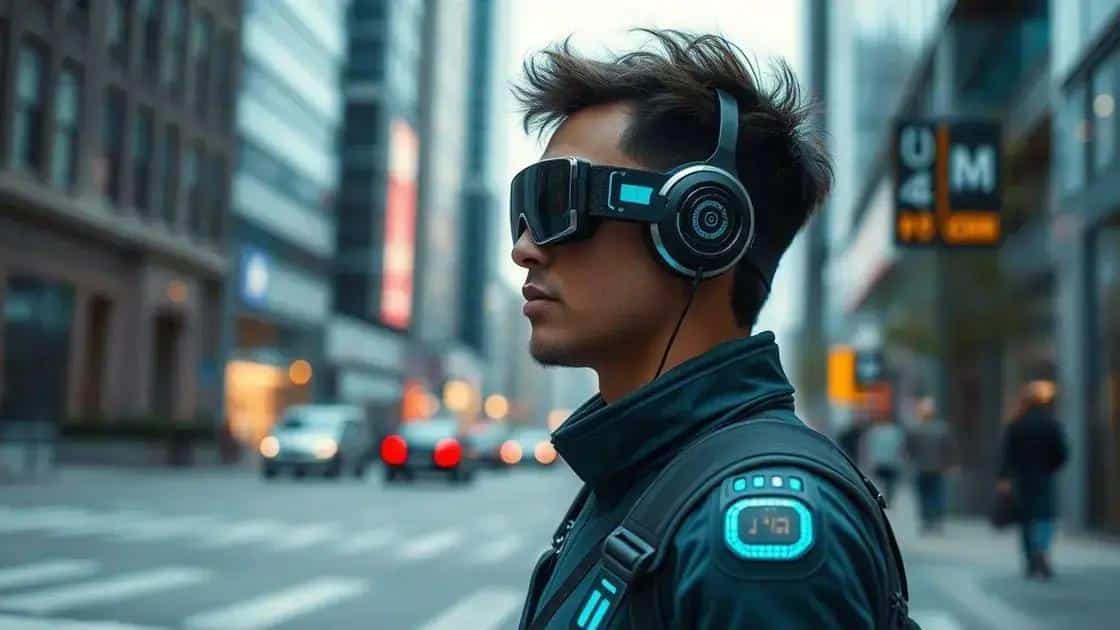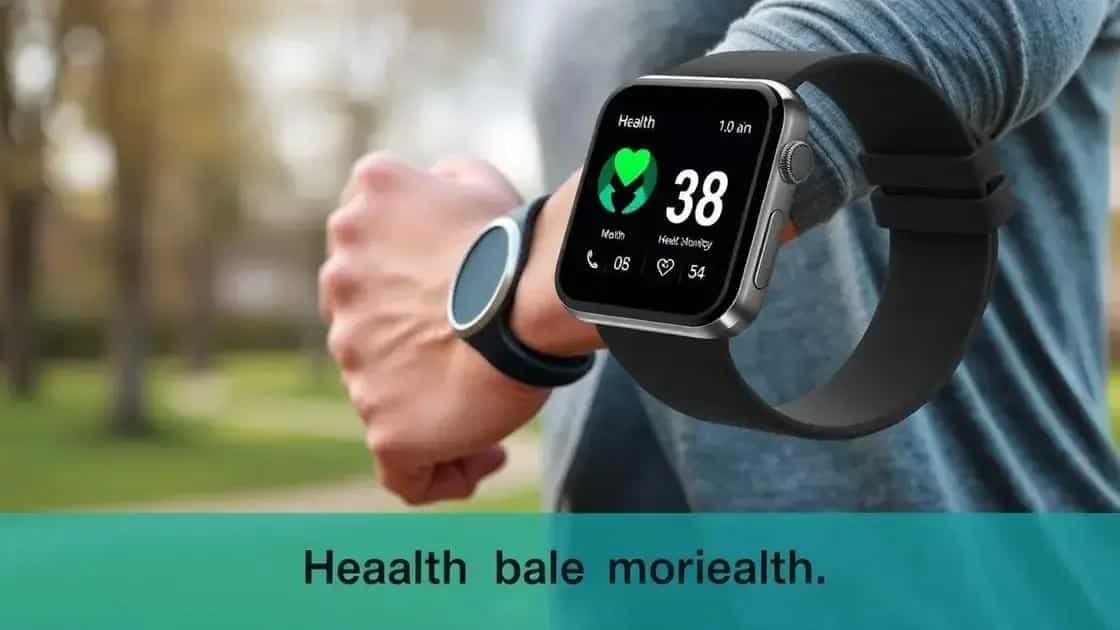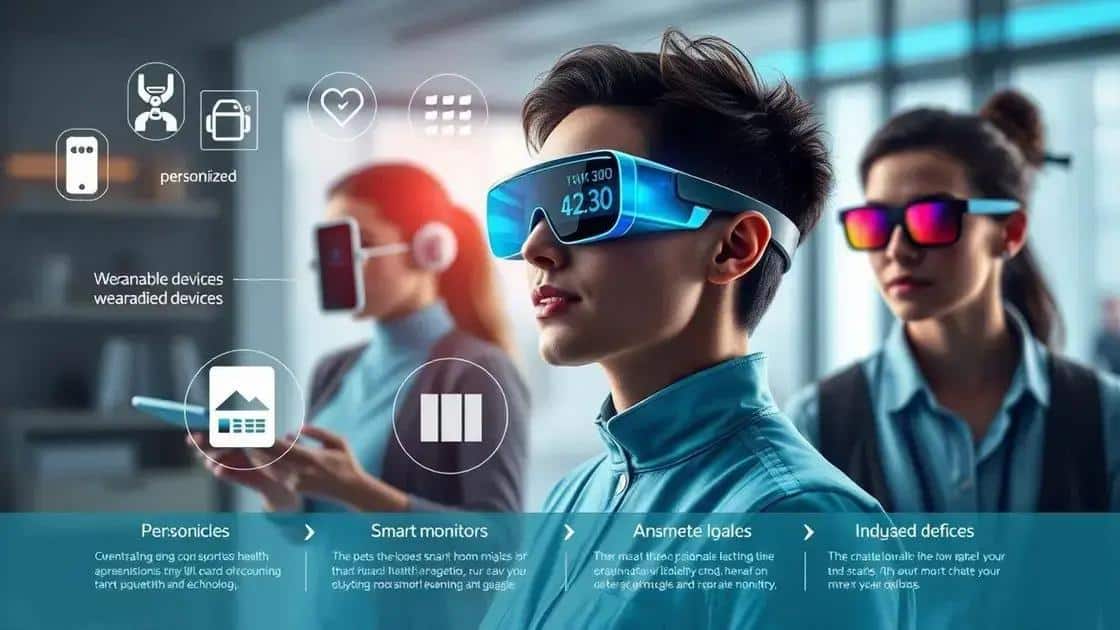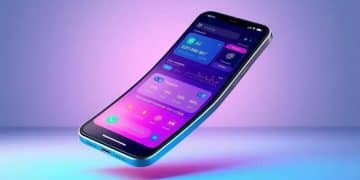Insights on wearable tech innovation: what’s next for us?

Wearable technology enhances health monitoring, personalizes user experiences, and integrates seamlessly with smart environments, driving innovation across various sectors.
Insights on wearable tech innovation are shaping the future of personal technology. With health monitoring and convenience at the forefront, these devices are changing how we interact with our daily lives. Have you ever wondered what new capabilities are just around the corner?
Understanding wearable tech: definitions and categories
Understanding wearable tech starts with grasping its definitions and categories. These devices are gadgets that can be worn on the body, often equipped with technology to collect data, communicate, and even interact with the user. They have transformed from simple fitness trackers to highly sophisticated devices that integrate functionality with fashion.
The main categories of wearable technology include:
1. Fitness Trackers
These wearables monitor health metrics like heart rate and steps. They help users set and achieve fitness goals while providing insights into their physical activity.
2. Smartwatches
Smartwatches serve as extensions of smartphones. They deliver notifications, answer calls, and even include fitness tracking features, blending style with utility.
3. Health Monitors
Devices like smart rings and advanced monitors provide health data for conditions such as diabetes or sleep apnea. They enable proactive health management through continuous monitoring.
4. Smart Glasses
Smart glasses offer augmented reality experiences, allowing users to receive information and navigate seamlessly. They represent the future of interactive technology.
As the demand for wearable tech grows, so does the variety and functionality. The integration of these devices into everyday life is seamless, enabling users to track health metrics, stay connected, and improve their daily routines. It’s fascinating to observe how innovations in this field continually enhance our lives. The flexibility of these devices allows for personalization, meeting the unique needs of users. Whether it’s tracking workouts, enhancing communication, or monitoring health, wearable tech has established itself as a vital part of modern living.
The impact of wearable tech on health and wellness
 The impact of wearable tech on health and wellness is profound. These devices have changed how we monitor and manage our health. With real-time data, users can make informed decisions about their fitness and well-being. Wearables empower individuals to take charge of their health through tracking and analysis.
The impact of wearable tech on health and wellness is profound. These devices have changed how we monitor and manage our health. With real-time data, users can make informed decisions about their fitness and well-being. Wearables empower individuals to take charge of their health through tracking and analysis.
Benefits of Wearable Tech for Health
Wearable devices provide a range of benefits including:
- Monitoring Vital Signs: Many wearables can track heart rate, blood pressure, and oxygen levels. This information is crucial for maintaining overall health.
- Activity Tracking: Fitness trackers record steps, calories burned, and active time, helping users to stay motivated and reach fitness goals.
- Sleep Analysis: Wearables can monitor sleep patterns, offering insights into sleep quality and duration, which are essential for proper recovery.
- Health Alerts: Some devices send alerts for irregular heartbeats or other concerning metrics, prompting users to seek medical advice.
These benefits illustrate how wearable technology fosters better health practices. Devices not only make tracking easier but also encourage users to adopt healthier lifestyles. Data collected through these gadgets can lead to personalized health insights, allowing for a tailored approach to personal fitness.
Wearable tech has also proven to be invaluable during health crises. For instance, during the pandemic, some wearables helped users monitor symptoms and stay informed about their health status. This capability has highlighted the importance of wearable technology in managing public health and personal wellness.
By integrating wearables into daily routines, individuals can actively participate in their healthcare. The ability to access critical health information at any time provides peace of mind. With ongoing advancements, the potential for these devices to promote better health outcomes will only increase.
Innovative applications of wearable technology
Innovative applications of wearable technology extend beyond fitness and health monitoring. These devices are revolutionizing various sectors by enhancing user experiences and improving efficiency. From the workplace to entertainment, wearables are designed to integrate seamlessly into daily life.
1. Workplace Safety
Wearable tech is increasingly used in industries like construction and manufacturing to promote safety. Devices can monitor environmental conditions and alert workers to hazards. For instance, helmets equipped with sensors can detect dangerous gases or unsafe temperatures, ensuring a safer work environment.
2. Enhanced Learning
In education, wearables are used to facilitate interactive learning experiences. Students can engage with augmented reality (AR) content through smart glasses, transforming traditional lessons into immersive experiences. This application is especially effective for science and history subjects.
3. Remote Healthcare Monitoring
Telehealth has benefited significantly from wearable devices. Patients with chronic conditions can use wearables to send health data to their doctors in real-time, allowing for timely interventions. This capability reduces hospital visits and enhances patient care.
4. Sports Performance Optimization
Athletes use wearables to track performance metrics such as speed, heart rate, and rhythm. Coaches analyze this data to develop tailored training programs. This helps athletes improve their skills and hones their competitive edge.
The impact of these applications extends far and wide. By integrating wearable technology into various fields, we can improve safety, boost learning outcomes, enhance healthcare, and optimize sports performance. As innovation continues, we will likely see even more exciting developments that further integrate wearable tech into our lives. The future holds endless possibilities for how these devices can enhance everyday experiences.
Future trends in wearable tech development
 Future trends in wearable tech development promise to reshape how we interact with technology daily. As advancements in technology continue quickly, wearables will become more integrated and intelligent. This evolution will enhance their functionality and usability across various sectors.
Future trends in wearable tech development promise to reshape how we interact with technology daily. As advancements in technology continue quickly, wearables will become more integrated and intelligent. This evolution will enhance their functionality and usability across various sectors.
1. Increased Personalization
Future wearables will offer tailored experiences for users. This includes personalized health insights based on individual data. For example, wearables will adapt to users’ lifestyles, recommending specific exercises or dietary choices.
2. Advanced Health Monitoring
Health monitoring capabilities will grow significantly. Future devices may track more than just heart rate and steps. New technologies may enable continuous monitoring of vital signs and even predict potential health issues before they arise.
3. Seamless Integration with Smart Environments
Wearables will increasingly connect with smart homes and cities. Imagine a device that can control home appliances, traffic lights, or public transportation systems based on your location and preferences. This level of integration will enhance efficiency and user convenience.
4. Use of Augmented and Virtual Reality
Augmented reality (AR) and virtual reality (VR) will be prominent in wearables. Future glasses or headsets might offer immersive experiences for everything from gaming to training. This technology will change the way we perceive and interact with digital content.
The trends indicate that wearable technology will become more essential in everyday life, providing seamless interactions, enhanced health monitoring, and personalized experiences. As these innovations unfold, they will offer exciting possibilities for consumers in various fields, from entertainment to healthcare and beyond. Staying ahead of these trends will allow users to maximize the benefits of their wearable devices and be part of a smarter, more connected world.
FAQ – Frequently Asked Questions about Wearable Technology
What are the primary benefits of wearable technology?
Wearable technology provides benefits such as health monitoring, fitness tracking, increased productivity, and real-time data access.
How can wearables help with health management?
Wearables can track vital signs, monitor physical activity, and provide alerts for health issues, enabling proactive health management.
Will wearables integrate with smart home devices?
Yes, future wearable devices are expected to integrate seamlessly with smart home systems, allowing for enhanced control and automation.
What role will augmented reality play in wearable tech?
Augmented reality in wearables will create immersive experiences, enhancing interactions in areas such as education, training, and entertainment.





